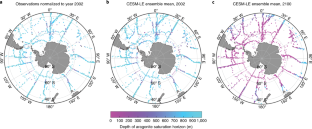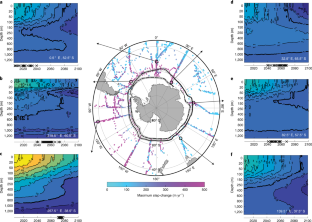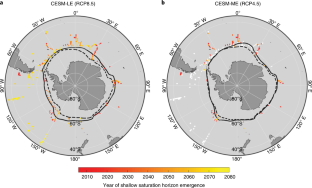Abstract
Models project that with current CO2 emission rates, the Southern Ocean surface will be undersaturated with respect to aragonite by the end of this century1,2,3,4. This will result in widespread impacts on biogeochemistry and ocean ecosystems5,6,7, particularly the health of aragonitic organisms, such as pteropods7, which can dominate polar surface water communities6. Here, we quantify the depth of the present-day Southern Ocean aragonite saturation horizon using hydrographic and ocean carbon chemistry observations, and use a large ensemble of simulations from the Community Earth System Model (CESM)8,9 to track its evolution. A new, shallow aragonite saturation horizon emerges in many Southern Ocean locations between now and the end of the century. While all ensemble members capture the emergence, internal climate variability may affect the year of emergence; thus, its detection may have been overlooked by ensemble average analysis in the past. The emergence of the new horizon is driven by the slow accumulation of anthropogenic CO2 in the Southern Ocean thermocline, where the carbonate ion concentration exhibits a local minimum and approaches undersaturation. The new horizon is also apparent under an emission-stabilizing scenario indicating an inevitable, sudden decrease in the volume of suitable habitat for aragonitic organisms.
This is a preview of subscription content, access via your institution
Access options
Access Nature and 54 other Nature Portfolio journals
Get Nature+, our best-value online-access subscription
9,800 Yen / 30 days
cancel any time
Subscription info for Japanese customers
We have a dedicated website for our Japanese customers. Please go to natureasia.com to subscribe to this journal.
Buy this article
- Purchase on Springer Link
- Instant access to full article PDF
Prices may be subject to local taxes which are calculated during checkout




Similar content being viewed by others
Data availability
CESM ensemble output is available from the Earth System Grid (http://www.cesm.ucar.edu/projects/community-projects/LENS/data-sets.html). GLODAPv2 data can be accessed from the project webpage (https://www.glodap.info/). WOA data are provided by the National Oceanographic Data Center (https://www.nodc.noaa.gov/OC5/WOA09/pr_woa09.html).
References
Orr, J. C. et al. Anthropogenic ocean acidification over the twenty-first century and its impact on calcifying organisms. Nature 437, 681–686 (2005).
Hauri, C., Friedrich, T. & Timmermann, A. Abrupt onset and prolongation of aragonite undersaturation events in the Southern Ocean. Nat. Clim. Change 6, 172–176 (2016).
Fabry, V. J., McClintock, J. B., Mathis, J. T. & Grebmeier, J. M. Ocean acidification at high latitudes: the bellwether. Oceanography 22, 160–171 (2009).
McNeil, B. I. & Matear, R. J. Southern Ocean acidification: a tipping point at 450-ppm atmospheric CO2. Proc. Natl Acad. Sci. USA 105, 18860–18864 (2008).
Moy, A. D., Howard, W. R., Bray, S. G. & Trull, T. W. Reduced calcification in modern Southern Ocean planktonic foraminifera. Nat. Geosci. 2, 276–280 (2009).
Hunt, B. et al. Pteropods in Southern Ocean ecosystems. Prog. Oceanogr. 78, 193–221 (2008).
Bednaršek, N. et al. Extensive dissolution of live pteropods in the Southern Ocean. Nat. Geosci. 5, 881–885 (2012).
Kay, J. E. et al. The Community Earth System Model (CESM) Large Ensemble project: A community resource for studying climate change in the presence of internal climate variability. Bull. Am. Meteorol. Soc. 96, 1333–1349 (2015).
Lovenduski, N. S., McKinley, G. A., Fay, A. R., Lindsey, K. & Long, M. C. Partitioning uncertainty in ocean carbon uptake projections: Internal variability, emission scenario, and model structure. Global Biogeochem. Cycles 30, 1276–1287 (2016).
Feely, R. A. et al. Impact of anthropogenic CO2 on the CaCO3 system in the oceans. Science 305, 362–366 (2004).
Ciais, P. et al. in Climate Change 2013: The Physical Science Basis (eds Stocker, T. F. et al.) Ch. 6 (IPCC, Cambridge Univ. Press, 2013).
Le Quere, C. et al. Global carbon budget 2017. Earth Syst. Sci. Data 10, 405–448 (2018).
Kroeker, K. J. et al. Impacts of ocean acidification on marine organisms: quantifying sensitivities and interaction with warming. Global Change Biol. 19, 1884–1896 (2013).
Ries, J. B., Cohen, A. L. & McCorkle, D. C. Marine calcifiers exhibit mixed responses to CO2-induced ocean acidification. Geology 37, 1131–1134 (2009).
Doney, S. C., Fabry, V. J., Feely, R. A. & Kleypas, J. A. Ocean acidification: the other CO2 problem. Annu. Rev. Marine Sci. 1, 169–192 (2009).
Sanderson, B. M., Oleson, K. W., Strand, W. G., Lehner, F. & O’Neill, B. C. A new ensemble of GCM simulations to assess avoided impacts in a climate mitigation scenario. Clim. Change 146, 303–318 (2015).
Lovenduski, N. S., Gruber, N. & Doney, S. C. Toward a mechanistic understanding of the decadal trends in the Southern Ocean carbon sink. Global Biogeochem. Cycles 22, GB3016 (2008).
Marshall, J. & Speer, K. Closure of the meridional overturning circulation through Southern Ocean upwelling. Nat. Geosci. 5, 171–180 (2012).
Olsen, A. et al. The Global Ocean Data Analysis Project version 2 (GLODAPv2)—an internally consistent data product for the world ocean. Earth Syst. Sci. Data 8, 297–323 (2016).
Lauvset, S. K. et al. A new global interior ocean mapped climatology: the 1° × 1° GLODAP version 2. Earth Syst. Sci. Data 8, 325–340 (2016).
Conrad, C. J. & Lovenduski, N. S. Climate-driven variability in the Southern Ocean carbonate system. J. Clim. 28, 5335–5350 (2015).
Xue, L. et al. Climatic modulation of surface acidification rates through summertime wind forcing in the southern ocean. Nat. Commun. 9, 3240 (2018).
Sarmiento, J. L. & Gruber, N. Ocean Biogeochemical Dynamics (Princeton Univ. Press, Princeton, 2006).
Freiwald, A., Fossa, J. H., Grehan, A., Koslow, T. & Roberts, J. Cold-water Coral Reefs: Out of Sight—No Longer Out of Mind (UNEP-WCMC, 2004).
Honjo, S., Francois, R., Manganini, S. J., Dymond, J. R. & Collier, R. W. Particle flux in the Pacific sector of the Southern Ocean. PANGAEA https://doi.org/10.1594/PANGAEA.787552 (2000) .
Honjo, S. Particle export and the biological pump in the Southern Ocean. Antarct. Sci. 16, 501–516 (2004).
Dadon, J. R. & de Cidre, L. L. The reproductive cycle of the thecosomatous pteropod limacina retroversa in the western South Atlantic. Marine Biol. 114, 439–442 (1992).
Franco, A. C., Gruber, N., Frölicher, T. L. & Kropuenske Artman, L. Contrasting impact of future CO2 emission scenarios on the extent of the CaCO3 mineral undersaturation in the Humboldt current system. J. Geophys. Res. Oceans 123, 2018–2036 (2018).
Lovenduski, N. S., Long, M. C. & Lindsay, K. Natural variability in the surface ocean carbonate ion concentration. Biogeosciences 12, 6321–6335 (2015).
Williams, N. L. et al. Assessment of the carbonate chemistry seasonal cycles in the Southern Ocean from persistent observational platforms. J. Geophys. Res. Oceans 123, 4833–4852 (2018).
Locarnini, R. A. et al. World Ocean Atlas 2009 Vol. 1 (ed. S. Levitus) (NOAA Atlas NESDIS 68, 2010).
Antonov, J. I. et al. World Ocean Atlas 2009 Vol. 2 (ed. S. Levitus) (NOAA Atlas NESDIS 69, 2010).
Garcia, H. E. et al. World Ocean Atlas 2009 Vol. 4 (ed. S. Levitus) (NOAA Atlas NESDIS 71, 2010).
Orr, J. C. & Epitalon, J.-M. Improved routines to model the ocean carbonate system: mocsy 2.0. Geosci. Model Dev. 8, 485–499 (2015).
Lee, K. et al. The universal ratio of boron to chlorinity for the North Pacific and North Atlantic oceans. Geochim. Cosmochim. Acta 74, 1801–1811 (2010).
Lueker, T. J., Dickson, A. G. & Keeling, C. D. Ocean cCO2 calculated from dissolved inorganic carbon, alkalinity, and equations for k1 and k2: validation based on laboratory measurements of CO2 in gas and seawater at equilibrium. Marine Chem. 70, 105–119 (2000).
Dickson, A. G. & Riley, J. P. The estimation of acid dissociation constants in seawater media from potentiometric titrations with strong base. I. The iconic product of water -- k w.Marine Chem. 7, 89–99 (1979).
Hurrell, J. W. et al. The Community Earth System Model: A framework for collaborative research. Bull. Am. Meteorol. Soc. 94, 1339–1360 (2013).
Long, M. C., Lindsay, K., Peacock, S., Moore, J. K. & Doney, S. C. Twentieth-century oceanic carbon uptake and storage in CESM1(BGC). J. Clim. 26, 6775–6800 (2013).
Landrum, L., Holland, M. M., Schneider, D. P. & Hunke, E. Antarctic sea ice climatology, variability, and late twentieth-century change in CCSM4. J. Clim. 25, 4817–4838 (2012).
Jiang, L.-Q. et al. Climatological distribution of aragonite saturation state in the global oceans. Global Biogeochem. Cycles 29, 1656–1673 (2015).
Acknowledgements
N.S.L., G.N.-G. and K.M.K. are grateful for support from the National Science Foundation (grant nos. OCE-1558225 and PLR-1543457). G.N.-G. was supported, in part, by the Significant Opportunities in Atmospheric Research and Science (SOARS) programme, NSF grant no. AGS-1641177. C.H. acknowledges support from the National Science Foundation (grant no. OCE-1459834). CESM computing resources were provided by CISL at NCAR. We thank B. Medeiros for providing model re-gridding scripts and N. Freeman for helpful comments on an earlier version of the manuscript.
Author information
Authors and Affiliations
Contributions
N.S.L. and K.M.K. re-gridded the CESM-LE and CESM-ME DIC output to the GLODAP/WOA grid, corrected the model DIC bias and calculated the aragonite saturation state from the bias-corrected model DIC projections. S.K.L. provided the modified GLODAPv2 mapped climatologies and expertise. G.N.-G. analysed the bias-corrected projections and wrote the manuscript. All authors were involved in the study design, discussed the results and helped write the manuscript.
Corresponding author
Ethics declarations
Competing interests
The authors declare no competing interests.
Additional information
Journal Peer Review information: Nature Climate Change thanks Nancy Williams and other anonymous reviewer(s) for their contribution to the peer review of this work.
Publisher’s note: Springer Nature remains neutral with regard to jurisdictional claims in published maps and institutional affiliations.
Supplementary information
Supplementary Information
Supplementary Figures 1–5
Rights and permissions
About this article
Cite this article
Negrete-García, G., Lovenduski, N.S., Hauri, C. et al. Sudden emergence of a shallow aragonite saturation horizon in the Southern Ocean. Nat. Clim. Chang. 9, 313–317 (2019). https://doi.org/10.1038/s41558-019-0418-8
Received:
Accepted:
Published:
Issue Date:
DOI: https://doi.org/10.1038/s41558-019-0418-8
This article is cited by
-
Severe 21st-century ocean acidification in Antarctic Marine Protected Areas
Nature Communications (2024)
-
Biogeochemical extremes and compound events in the ocean
Nature (2021)
-
Southern Ocean carbon export efficiency in relation to temperature and primary productivity
Scientific Reports (2020)



